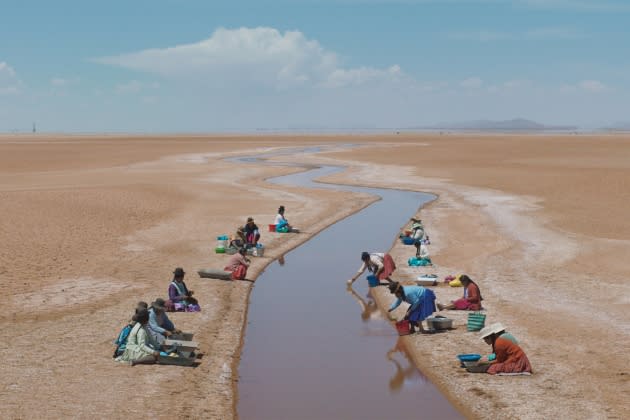‘Utama’ Review: Home Is Where the Water Is in Breathtaking Bolivian Character Portrait

When one is asked to picture those who are most impacted by global warming, the imagination flashes to Inuits on a melting ice floe or Maldives natives threatened by rising tides, not Bolivian shepherds who graze their livestock on the Altiplano, nearly 12,000 feet above sea level. But the residents of these remote highlands are also endangered, as director Alejandro Loayza Grisi reveals in his sublime, quietly elegiac feature debut, “Utama,” focusing on an elderly couple who refuse to relocate to the nearby city of La Paz, even as mountain glaciers melt, rains become less reliable and their herd of llamas slowly succumb to dehydration.
Played by actual couple José Calcina and Luisa Quispe (authentic, nonprofessional actors whom Loayza Grisi had to convince to participate), long-married Virginio and Sisa share a small mud house without electricity or running water. Fetching water has always been a chore for Sisa — that’s her responsibility, Virginio sternly reminds her, whereas he handles the animals — but lately, it’s become harder than ever. Normally, she can find what she needs in the nearby town, but the well has run dry, and it’s a long walk to the shrinking river, which has dwindled to hardly the width of a one-lane road. Soon it may be no more.
More from Variety
Few would envy Virginio and Sisa their ascetic existence, and yet, it’s all the pair have ever known — and they have no intention of leaving. The film’s title means “our home” in their Quechua dialect, and these two intend to die there, despite the polite appeals of their grandson Clever (Santos Choque), who visits the couple with the mission of convincing them to move to the city. He’s a typical millennial, always on his phone, oblivious to the beauty all around him, whereas Loayza Grisi bows in awe of the film’s locations.
Before turning to cinema, the helmer worked as a still photographer, and together with DP Barbara Alvarez (“The Headless Woman”), he conceived a distinct visual sensibility for the film. From the breathtaking opening shot — of Virginio walking alone across a dark dry plain, toward the blazing sunrise beyond the mountains — the film looks quite unlike anything else. Movies made in this corner of South America are so few, so seldom exported, the scenery alone seizes the imagination, rendering spiritual what might seem mundane if we only saw it more often. So many buy calendars to have the same view this couple enjoys from their front yard. Can it last?
When rains don’t come, Virginio joins a handful of others on a mission: The community must sacrifice one of their animals to the deity who controls the weather — a ritual they call “sowing water on the mountain.”
When the characters are outdoors, “Utama” is told largely in dramatic hi-def long shots, the widescreen horizon typically centered in the frame, faded blue skies above, cracked earth below, the humans reduced to little more than tiny silhouettes. Indoors, things are more intimate, as the camera shares the room where the couple sleep. Here, “Utama” observes its characters in close-up, basking in the comfort of silences made possible by years of marriage. A gesture as simple as Sisa reaching for Virginio’s hand at the table says everything about the soul mates: They are one another’s world.
Between them, speech is scarce and largely unnecessary — or so they think. Lately, Virginio hasn’t been well. He suffers from a cough, which he tries to keep hidden from his wife. Every day, he takes the llamas out to graze. The bright pink tassels pinned to their ears supply a dose of color against the desiccated vistas. In one scene, Virginio shuffles to where Sisa sits in the garden and puts his head in her lap without saying a word. Is he telling her something? Turns out, these two have their secrets.
Clever may be clueless in some respects, but it doesn’t take him long to realize that something’s wrong. He fetches a doctor to examine his grandfather, insisting that they return with him to the city. But what would they do there? These two generations don’t even speak the same language.
“Time has gotten tired,” a village friend tells Virginio in Quechua. Virginio is tired, too, but also stubborn. Most of the houses in town have been abandoned, but he isn’t leaving — unless it’s to go to “the lake” to die, as is their custom. Is that where Virginio was headed in the opening shot? He tells Clever a story of how the condor commits suicide “when he feels he’s not useful anymore.” These majestic birds serve as a recurring motif throughout the film, watching over the changing land like gods (while climate change remains the unspoken culprit). Conservationists have classified the Andean condor as “near threatened,” which would be a good way to describe the Indigenous denizens of the Altiplano as well. How much longer will the people of “Utama” have a home?
Best of Variety
Sign up for Variety’s Newsletter. For the latest news, follow us on Facebook, Twitter, and Instagram.

 Yahoo Movies
Yahoo Movies 